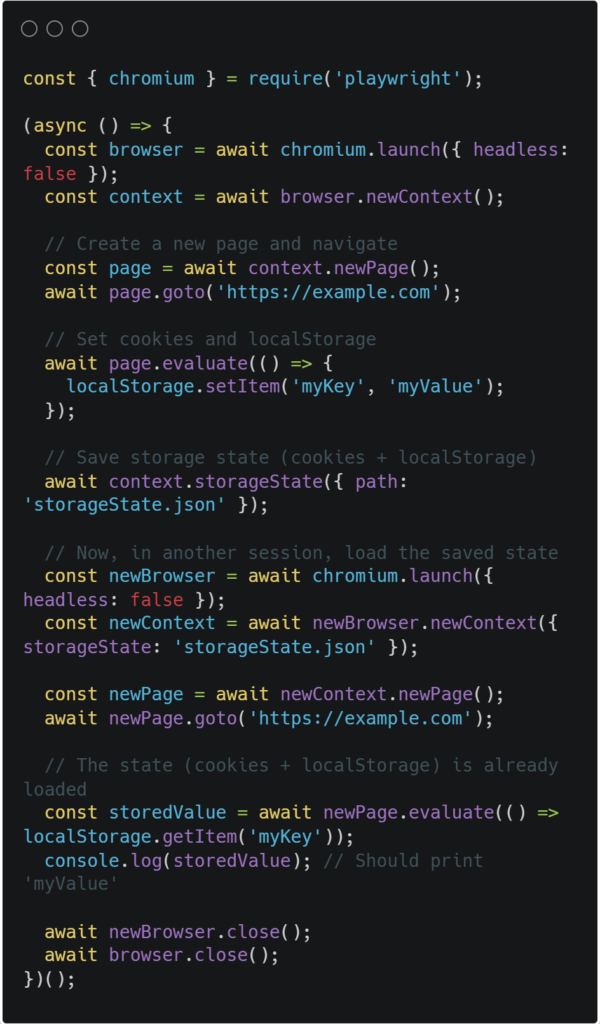
Microfrontends (MFEs) have revolutionized frontend development by enabling modular, scalable, and independently deployable UI components. However, testing such distributed architectures introduces unique challenges—especially in UI automation.
Playwright, a modern end-to-end testing framework, offers powerful solutions to tackle these challenges effectively. In this deep-dive blog, we’ll explore:
✔ Key challenges in testing Microfrontends
✔ How Playwright solves these challenges
✔ Best practices for scalable test automation
Let’s Explore…
1. Cross-Application State Management
Challenge:
- MFEs share state (auth tokens, user preferences) across different teams’ codebases
- Tests fail when state isn’t synchronized between micro-apps
Solution:
- Context Isolation: Create separate browser contexts for each test scenario
const context = await browser.newContext();
const page = await context.newPage();
- State Reuse: Persist and share authentication state across tests
// Save state
await page.context().storageState({ path: ‘authState.json’ });
// Reuse state
const context = await browser.newContext({ storageState: ‘authState.json’ });
2. Asynchronous Loading & Race Conditions
Challenge:
- Independent MFE bundles load at different times
- UI tests fail due to elements not being ready
Solution:
- Auto-Waiting: Built-in assertions wait for elements
await expect(page.getByRole(‘button’, { name: ‘Submit’ })).toBeEnabled();
- Network State Control: Wait for critical resources
await page.waitForLoadState(‘domcontentloaded’);
await page.waitForResponse(response =>
response.url().includes(‘/api/data’) && response.status() === 200
);
3. Versioning & Dependency Conflicts
Challenge:
- Different teams use incompatible framework versions
- Shared dependencies cause rendering inconsistencies
Solution:
- Visual Regression Testing: Catch UI discrepancies
expect(await page.locator(‘.checkout-form’).screenshot())
.toMatchSnapshot(‘checkout-v2.png’);
- Dependency Mocking: Isolate version-specific behavior
await page.route(‘**/react-version’, route => route.fulfill({ body: JSON.stringify({ version: ‘18.2.0’ }) }));
4. Cross-Origin iframes & Shadow DOM
Challenge:
- Encapsulated components break traditional selectors
- iframe boundaries prevent direct element access
Solution:
- Shadow DOM Piercing: Directly access shadow roots
await page.locator(‘custom-element >>> .inner-button’).click();
- Frame Context Switching: Target iframes precisely
const frame = page.frameLocator(‘#payment-iframe’);
await frame.locator(‘#credit-card’).fill(‘4111111111111111’);
5. CI/CD Pipeline Integration
Challenge:
- Independent deployments require targeted test runs
- Full regression suites become too slow
Solution:
- Test Partitioning: Run only affected MFE tests
npx playwright test tests/checkout/ –project=chromium
- Parallel Execution: Scale across workers
// playwright.config.ts
export default {
workers: process.env.CI ? 4 : undefined
};
Why Playwright for Microfrontends?
| Challenge | Playwright Solution | Alternative Tools Limitation |
| Shared State | Isolated contexts & storage reuse | Cypress: No easy state sharing |
| Async Loading | Auto-waiting & network idle detection | Selenium: Manual waits required |
| Version Conflicts | Visual regression testing | Cypress: Limited snapshot management |
| iframe/Shadow DOM | Native piercing selectors | Selenium: Complex workarounds needed |
Read Also: How to Perform Visual Regression Testing with Playwright?
Best Practices for Scalable Test Automation
1. Modular Test Architecture
-> Organize Tests by Feature or MFE Scope
Instead of monolithic test suites, structure tests based on:
- Microfrontend boundaries (e.g., auth/, checkout/, dashboard/)
- Business domains (e.g., user-management/, payment-flow/)
For ex:
tests/
├── auth/
│ ├── login.spec.ts
│ └── registration.spec.ts
├── dashboard/
│ ├── widgets.spec.ts
│ └── analytics.spec.ts
└── checkout/
├── cart.spec.ts
└── payment.spec.ts
-> Reuse Shared Utilities
Extract common functions (e.g., login, API mocking) into helper files:
// utils/auth.ts
export async function login(page: Page, user: string) {
await page.fill(‘#username’, user);
await page.click(‘#login-btn’);
}
2. Optimize Test Performance
-> Parallel Test Execution
Run independent tests concurrently to reduce execution time:
npx playwright test –workers 4 (# Runs 4 tests in parallel )
-> Selective Test Execution
Run only affected tests using:
- Tag-based filtering (@smoke, @regression) => npx playwright test –tags=@somke
- File-based targeting => npx playwright tests/auth/login.spec.ts
-> Smart Waiting Over Hard Delays
To avoid page.waitForTimeout(5000) then use Playwright’s built-in auto-waiting:
await expect(page.locator(‘.success-message’)).toBeVisible();
3. Enhance Test Reliability
-> Mock External Dependencies
Isolate tests by mocking:
- APIs (using page.route())
- Third-party services (e.g., Stripe, Auth0)
Browser storage (localStorage, cookies)

-> Implement Retry Logic for Flaky Tests
Configure retries in playwright.config.ts:
export default {
retries: 2, // Retries failed tests twice
};
4. Maintainable Test Design
-> Use Page Object Model (POM) or Component Object Model (COM)
Encapsulate UI interactions for reusability:
class LoginPage {
constructor(private page: Page) {}
async login(username: string) {
await this.page.fill(‘#username’, username);
await this.page.click(‘#submit’);
}
}
-> Prioritize Accessibility & Semantic Selectors
Avoid brittle XPath/CSS selectors—use data-testid or ARIA roles:
<button data-testid=”login-button”>Sign In</button>
await page.locator(‘[data-testid=”login-button”]’).click();
5. CI/CD & Reporting Integration
-> Run Tests in Pipeline Stages
- PR Checks: Fast smoke tests (~5 mins)
- Nightly Runs: Full regression suite
- Post-Deploy: Sanity tests on production
-> Generate Actionable Reports
Use:
- Playwright HTML Report (npx playwright show-report)
- JUnit/Allure for CI Dashboards
- Slack/Alerts for Failures
Example CI (GitHub Actions):
- name: Run Playwright Tests
- run: npx playwright test –reporter=html
6. Visual & Contract Testing
-> Visual Regression Testing
Detect UI changes with screenshots:
expect(await page.screenshot()).toMatchSnapshot(‘homepage.png’);
-> Contract Testing for APIs
Ensure MFE-backend compatibility using tools like Pact or Postman.
Why Playwright Wins for Microfrontends?
✔ Handles iframes/Shadow DOM natively → No hacks for modular UIs
✔ True cross-origin testing → Perfect for independently deployed MFEs
✔ Faster execution → Parallelism + multi-browser support
✔ All-in-one solution → E2E + component + visual testing
Conclusion
Microfrontends demand a testing strategy as modular as the architecture itself. Playwright’s auto-waiting, multi-context support, and visual testing capabilities make it uniquely suited for the challenge.
The winning formula? Isolate, parallelize, and automate smartly.
By combining Playwright’s strengths with component testing, CI/CD integration, and contract validation, teams can achieve:
– Faster feedback cycles
– More reliable deployments
– Truly independent testing
The result? A scalable testing approach that grows with your micro frontend ecosystem.
Ready to optimize your MFE testing? Start with parallel execution and mocking, then expand from there. Get in touch with a leading Web Automation Testing Company…


